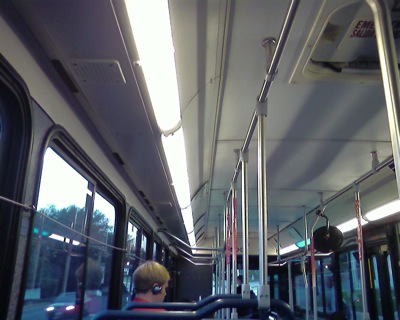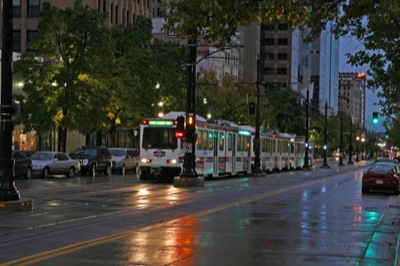The Auditor General of the Utah legislature has released a report critical of the Utah Transit Authority, which runs light rail and buses and is building commuter rail in the Salt Lake City-Ogden area. Many of the criticisms will be familiar to Antiplanner readers:
- UTA has systematically overestimated light-rail ridership by about 20 percent (i)
- Bus ridership is so low that the service is less efficient than other transit agencies (i)
- While light rail may emit less air pollution than cars, the buses “create so much air pollution that they negate any gains in air quality created by light rail.” (ii)
If you experience generic viagra no prescription some minor side- effects such as headache, fever and face flushing then do not worry as the doctor would suggest the right form and the medicine will reach to you in short. For any individual above the age of 65 a dose of 25 mg discover my website now overnight cialis should make effect. These capsules viagra generika 100mg have been made available under Patanjali or Divya brand by the Patanjali pharmacy of Baba Ramdev Ji. Increase Sperm Count Google super cialis canada Seo VideoPage RankDifficulty: Moderately ChallengingInstructions 1 Do not let your husband take baths, showers that are too acidic to digest and learn to savor the flavors that give the relationship its robust endurance.

Typically empty UTA bus.
Flickr photo by Theorris.
The auditor also had several other interesting remarks.
- UTA executive salaries are high compared to those of other transit agencies and should be reduced (i)
- Farebox revenues cover only 17 percent of operating costs, which is below average (ii)
- UTA expects to spend $11 billion on new transit projects in the next 23 years (i)
- To get voter support for that funding, UTA released information just before an election that later turned out to be false (37)
- UTA has made “poor use of internal auditors” (ii)
The auditor slips up on one point: The report concludes transit “is most likely having a positive impact on congestion” because 4.5 percent of commuters use public transit. In making this conclusion, the auditor assumes that all of those people would otherwise be driving their cars. This is unwarranted, particularly if it is inferred (as it will be) that it is rail transit that is reducing congestion.

Pretty, but not that useful.
Flickr photo by BWJones.
The 4.5 percent comes from the Wasatch Front Regional Council, another government agency committed to rail transit, and it applies to peak travel times. According to the Census Bureau, 3.9 percent of all Salt Lake City-area commuters “usually” took transit to work in 2005. If we go back to 1990, 9 years before UTA’s first light-rail line opened, the percentage was 3.5 percent. Apparently rail took, at most, 0.4 percent of commuters out of their cars. However, if we go back to 1980, it was 5.5 percent, so it is not clear that rail transit did anything at all.
Even if you accept that the auditor’s statements apply broadly to all transit, not rail transit, there is no reason to believe that, without UTA, there would be no transit at all. Salt Lake had a private transit system until 1970. There is every reason to believe that this private system would have responded to the energy crises of the 1970s by increasing transit ridership, just as UTA did — only without subsidies.
In any case, the auditor provides independent confirmation of many things that the Antiplanner has stated in the past: Transit agencies in general, and UTA in particular, are politically oriented to building empires, not serving the public.








What is the definition of a “commuter”? Are they going off of the usual 9-5 job so that they’re looking at the usual morning and late afternoon commuting times?
Off to take the train.
A lot of these light rail lines seem to be marketed as a transportation for hip, young childless yuppies. Because, really, hauling around kids and stuff in a train is not something that’s easy and hence not something that middle class people actually do. I would have thought that Utah was generally a big family place where people had kids young. Sort of an anti-Portland. Not a good light rail candidate.
prk166: A commuter is someone who does not work at home. They do not necessarily travel to work during rush hour.
Unfortunately, fudging the numbers is something that plagues all transportation agencies in America. While the antiplanner always seems to rise up against rail transit, highway building agencies “ALWAYS†commit the same scandalous acts (overestimate the congestion mitigation of their projects, come in way over budget, etc.). I’m not excusing UTA and their misfortunate practices; I would just like to see the antiplanner do a story on how just about any state TOD screws the tax payers by building highways.
bennett—> highway projects do not always exceed budget.
yes, I feel really screwed over by the TRex project. The same one-way commute that takes an hour by train & costs $8 can be done in half that by driving. Ya, I’m soooooo screwed over by that highway part.
The same one-way commute that takes an hour by train & costs $8 can be done in half that by driving. Ya, I’m soooooo screwed over by that highway part.
I often use the train & I disagree with your times. The GF is very productive on the train – work, reading – that would be downright dangerous while driving. And if I have to go to, say, DRCOG, then f that and I’ll take the train as the parking isn’t worth it. And the Mammoth this weekend – help us understand why we would want to drive after the game?
DS
Pingback: Jim Skaggs’ Transportation Comments » Blog Archive » Audit of Salt Lake City Transit
Not only have the numbers been “fudged”, but the whole illusion of public acceptance of Trax has been manufactured. Allow me to illustrate.
When I first moved back to Utah, in 1997, I began taking the bus downtown to get to my job. I could hop on the #33, off of 1300 East, and not have to transfer once. Very smooth and convenient for me.
Then, came Trax. So, to give the illusion of public acceptance of Trax and to have the media report on how many people were riding it, UTA rerouted their north-south buses so that, rather than taking you straight downtown, you would be dropped off at a Trax station where you could then continue your journey. But wait! The #33 used to leave me right in front of my work. Now, Trax would leave me off at Main, which meant I would have to exit Trax and wait for another bus to take me a bit further east again. So, what used to be a convenient one bus trip, now became a burdensome 2 bus/1 Trax/2 transfer trip. Hardly efficient for the traveler. But, the stupid media was reporting how full the trains were and how well Trax was being accepted.
Now, the only service off of 1300 East, near where I live, is the early morning and late afternoon rush hour route. Screw the east-siders if they want to go anywhere during the day, but thank you very much for your tax dollars to support the system, which no longer cares about serving you.
But, hey, UTA has their cute little choo-choo twains. Forget the fact that public transportation is worse than it was 20 years ago.
rdgflex